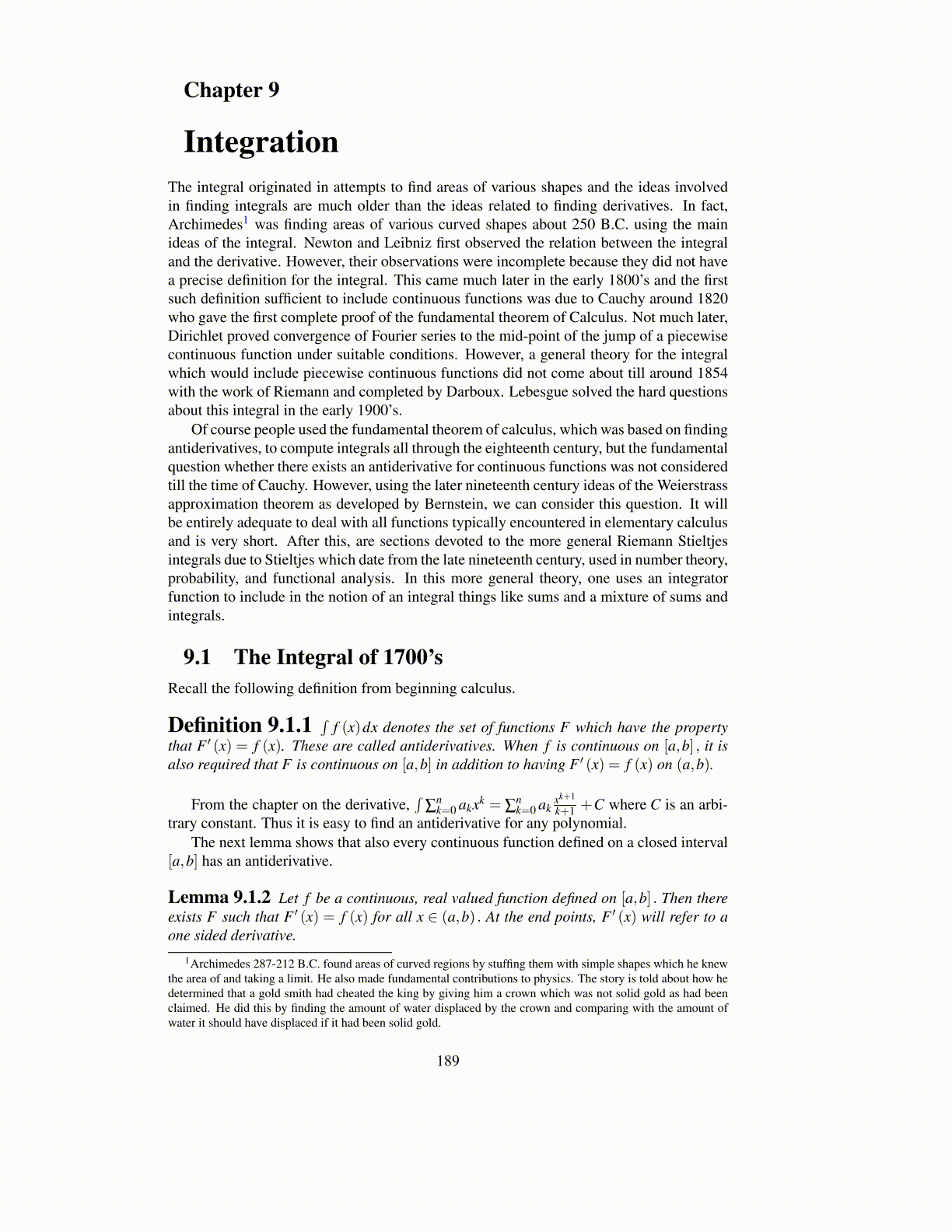
9.1. THE INTEGRAL OF 1700’S 189
Proof: Suppose F,G are both antiderivatives. Then letting
H (x)≡ F (x)−G(x) ,H ′ (x) = 0
it follows by the mean value theorem, H (b)−H (a) = 0(b−a) = 0 so F (b)−G(b) =F (a)−G(a) which implies F (b)−F (a) = G(b)−G(a).
Proposition 9.1.5 The above integral is well defined for f continuous on [a,b] andsatisfies the following properties.
1.∫ b
a f dx = f (x̂)(b−a) for some x̂ between a and b, x̂ /∈ {a,b} . Thus∣∣∣∫ b
a f dx∣∣∣ ≤
∥ f∥|b−a| .
2. If f is continuous on an interval which contains all necessary intervals,∫ c
af dx+
∫ b
cf dx =
∫ b
af dx, so
∫ b
af dx+
∫ a
bf dx =
∫ b
bf dx = 0
3. If F (x)≡∫ x
a f dt, Then F ′ (x) = f (x) . Also,∫ b
a(α f (x)+βg(x))dx = α
∫ b
af (x)dx+β
∫a
βg(x)dx
If a < b, and f (x)≥ 0, then∫ b
a f dx≥ 0. Also∣∣∣∫ b
a f dx∣∣∣≤ ∣∣∣∫ b
a | f |dx∣∣∣.
4.∫ b
a 1dx = b−a.
Proof: The integral is well defined by Proposition 9.1.4 and Lemma 9.1.2. Consider 1.Let F ′ (x) = f (x) ,F as in Lemma 9.1.2 so∫ b
af (x)dx≡ F (b)−F (a) = f (x̂)(b−a)
for some x̂ in the open interval determined by a,b. This is by the mean value theorem.Hence
∣∣∣∫ ba f dx
∣∣∣≤ ∥ f∥|b−a| .Now consider 2. Let F ′ = f on a closed interval which contains all necessary intervals.
Then from the definition,∫ c
af dx+
∫ b
cf dx = F (c)−F (a)+F (b)−F (c) = F (b)−F (a)≡
∫ b
af (x)dx
Next consider 3. For F (x) ≡∫ x
a f (x)dx, the definition says that F (x) = G(x)−G(a)where G is an antiderivative of f . Since F (x) = G(x)−G(a) , f = G′ = F ′. It follows thatF ′ (x) = f (x) with an appropriate one sided derivative at the ends of the interval. Now letF ′ = f ,G′ = g. Then α f +βg = (αF +βG)′ and so∫ b
a(α f (x)+βg(x))dx ≡ (αF +βG)(b)− (αF +βG)(a)
= αF (b)+βG(b)− (αF (a)+βG(a))
= α (F (b)−F (a))+β (G(b)−G(a))
≡ α
∫ b
af (x)dx+β
∫a
βg(x)dx